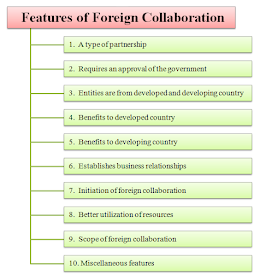What are Features of Foreign Collaboration?
 What are Features of Foreign Collaboration?
What are Features of Foreign Collaboration?
The nine important features of foreign collaboration are depicted below.
The main characteristics or features of foreign collaboration are as follows:
- A type of partnership.
- Requires an approval of the government.
- Entities are from developed and developing country.
- Benefits to developed country.
- Benefits to developing country.
- Establishes business relationships.
- Initiation of foreign collaboration.
- Better utilization of resources.
- Scope of foreign collaboration.
- Miscellaneous features.
Now let's discuss each feature of foreign collaboration one by one.
1. A type of partnership
Foreign collaboration is a type of partnership (alliance) between a domestic entity and an abroad based entity. In such an alliance, each partner plays some crucial roles, which are as follows:
- Generally, an abroad based entity provides support for finance, technology, engineering, management, etc.
- On the other hand, a domestic based entity provides cheap labour, high-quality raw materials, land and so on.
Here, domestic and abroad based entity share their profits as per profit-sharing ratio mentioned in their contract (legally enforceable agreement).
2. Requires an approval of the government
Before initiating foreign collaboration, collaborating entities (domestic and abroad) must seek permission from the government of the domestic country.
The government gives approval only when the contract of foreign collaboration is prepared in accordance with the industrial or foreign policy of its country.
3. Entities are from developed and developing country
In foreign collaboration, one or more abroad entities are generally from developed countries like U.S.A., Germany, Japan, etc. Whereas, a domestic entity is from a developing country or less-developed country (LDC). Some examples of developing countries are India, Sri-Lanka, Indonesia, and so on.
4. Benefits to developed country
The benefits of foreign collaboration to a developed country are as follows:
- Foreign collaboration helps a developed country earn good returns on its overall investments made in a domestic country.
- It also aids a developed country earn a good reputation for providing financial and technical assistance (support) to the developing country.
5. Benefits to developing country
The benefits of foreign collaboration to a developing country are as follows:
- Foreign collaboration helps a developing country to get finance, technology, machinery, know-how, management and technical expertise, etc. from a developed country.
- It also assists a developing country to achieve a faster economic growth.
6. Establishes business relationships
Foreign collaboration establishes business (trade) relationships among different countries. It removes their economic gaps (hurdles) and brings them closer to each other.
7. Initiation of foreign collaboration
A foreign collaboration is initiated at the government and/or corporate level.
- At governmental level foreign collaboration, a government of some abroad country collaborates with the government of a domestic country.
- Similarly, at corporate level foreign collaboration, a company from some abroad country collaborates with the company from a domestic country. These companies may be either private or public in nature.
8. Better utilization of resources
Though developed countries are good with finance, technology, management and technical expertise, generally, they face difficulties to meet a continuous supply of low-cost labour and quality raw materials.
On the other hand, generally, a developing country has more availability of low-cost labour and plenty of quality raw materials.
Foreign collaboration brings developed and developing country together and helps them to satisfy each other's needs by exchanging their excess resources. Finally, this leads to a better utilization of available resources.
9. Scope of foreign collaboration
The scope of foreign collaboration is very wide. It covers core business activities such as:
- Finance,
- Production,
- Management and Technical consultancy,
- Advertising and Marketing, etc.
10. Miscellaneous features
Miscellaneous features of foreign collaboration are listed as follows:
- Foreign collaboration reduces unemployment in a developing country.
- It improves infrastructure in a developing country.
- It helps to increase revenue of the governments in the form of taxes and duties.
- It also aids to achieve economic growth (progress) of developed and developing country.

No Comment Yet
Please Comment